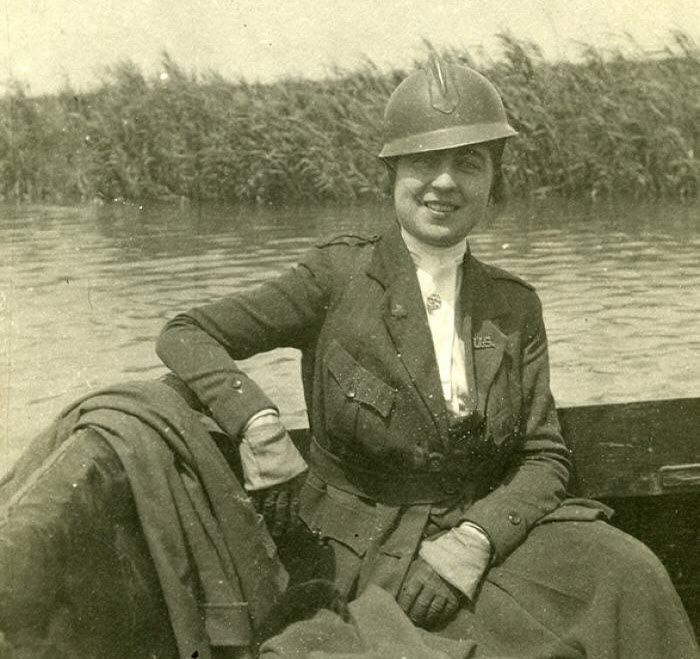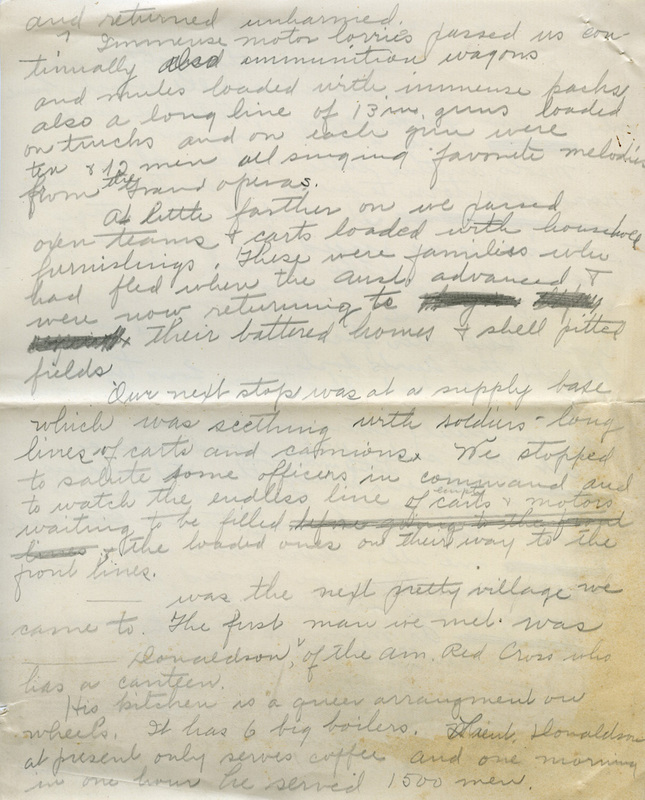
While her husband left for Cairo and Palestine, Fran stayed in Italy and joined the American Red Cross. She was stationed in Genoa with the wives of Theodore Jr. and Kermit Roosevelt. Fran was reportedly the only woman to visit the Italian Front during that period, where she came under sniper fire during the Battle of Piave River in June of 1918. These three double-sided pages are her journal notes of that experience. They were found loose with her journal, and were never intergrated.
With shells whizzing over our heads and shrapnel bursting and the [illegible] with its anti-aerial barrage going at full force around us, accompanied by three army officers with their hands on their revolvers, ready to pull them at any instant in case the men in the trenches who have not seen a woman in months, dared approach me. I visited the battlefield on the lower Piave which was the scene of the desperate fighting on June 23rd when the Italians forced the Austrians to give up the small fruits which their offensive had yielded.
In an Italian Admiralty motor boat we [illegible] through the lagoons, stopping first at Porte Grand where there is a rest camp and where the Am. Red Cross has a supply base. We found two Am. Boys in charge of the station, in their hut — with fish nets made of mosquito netting over their heads which made them look like Creole Queens on their wedding day.
From Porte Grand it was about a twenty minute ride to Capo Sile. We passed floating artillery along the way. The guns are mounted on pontoons and are moored to the bank of the canal.
If an enemy areoplane[sic] or observation balloon…
…should discover their position — which is difficult for they are painted the same color as the reeds in which they stand, they simply move to another place.
Observation balloons are up all the time. They have observers whose business is to watch every shot fired from these batteries. The balloons are equipped with wireless and if a gun is shooting too far or too short it is wirelessed to the commanding officers of the battery who changes the range.
I bent over the side to dip my hands in the water. Capt. Fernando said, “This water is not clean, there are hundreds of bodies of dead Austrians lying on the bottom of this canal.”
This was the first idea I had of the desperate fighting which five months ago was a thriving pretty village was now a heap of bricks leveled to the ground. Just the four walls of the church were left standing — like a huge crust.
We walked as far as the Piave and crossed on a new pontoon bridge build next to the old bridge, which had been destroyed by the enemy after he found out he would never hope to cross it.
On the other side of the river the Italian had crude[?] their dug-outs in the river bank. There they were sleeping on the damp earth…
…as many as twenty in one cave.
Some of the soldiers were playing cards, some were washing[?] their cloths, others were cleaning up the debris and burying the dead. All about were fresh mounds with tiny wooden crosses on top and heaps of Austrian bayonets, bullets, helmets, guns and clothing.
From here we motored in a Gov't Fiat to Musile, over a high embankment which was the main road of communication to the various Italian batteries.
The Italians had drowned again the plains on either side, which they inundated so thoroughly last November when the Austrians made their great advance.
The whole land was completely submerged with only here and there little fortified fractions of dry land.
On one side of this high road were huge straw mats interwoven with green. The purpose of which was to hide it from the view of the enemy.
Big guns (called 210's) which shoot shells 8 inches in diameter and almost 2 ft long were camouflaged. They were covered with big branches of trees.
Camouflage is mainly used to protect against areoplanes[sic] and balloons. The enemy sends up scouting planes to photograph the other side's lines.
As soon as the observer returns — the pictures are developed and enlarged and handed in to headquarters. With a powerful glass these …
…photographs are examined to find trenches — batteries, supply stations, munition huts, areoplane[sic] camps and batteries.
Artists have discovered, by painting huts and stations with smuggy dots of various colored paints blended in together, that it gives the idea, from a great height of nature, and from a picture, the enemy is unable to discover important positions.(sic)
Musile is only forty yards from the Austrian front lines. Instead of walking down the main street, we were compelled to take a side path which twined in and out thick bushes, to prevent been seen.
We went to the church, which had only the front wall and one side one [left] standing.
Capt. Tozzi found a German map among the refuse which was marked with a blue pencil showing the distance they hoped to advance.
The ground bore traces enough by its shell-pitted breath of the desperate fighting that had taken place. It had happened so recently that there had not been time to clear the place of its debris.
In an officers dugout I found a cane and an overcoat hanging on the wall.…
…All about were guns, ammunition, belts, helmets and bayonets.
The enemy had evidently sighted us for he sent some shrapnel which burst only a few yards away. We that it time, time to be riding on.
Meolo, another little village along the rod was torn to pieces by Austrian shells. It looked like stage settings as we passed by … just, the front was of many of the houses and shops and the church were left standing.
The heaviest fighting took place at Croce. The piles of corpses lying around showed how heavily the Austs lost.
The Aust. took this town four times and four times were beaten back. They finally were completely exterminated here.
At one side of the road was a wire stretcher clotted with blood which the Ital. soldiers were using to carry the dead bodies to the graves. The stench was so terrific it made me ill. There were new made graves everywhere we looked, with tiny wooden crosses marking them.
As many as twenty and thirty soldiers are buried in one grave.
Italian areoplanes[sic] whizzed over our heads and the evening's aerial[sic] barrage sprung up making a black cloud of smoke. The big Capronis dodged about successfully…
…and returned unharmed.
Immense motor lorries passed us continually also ammunition wagons and mules loaded with immense packs also a long line of 13in guns leaded on trucks and on each gun were ten and 12 men all singing favorite melodies from the grand operas.
A little farther on we passed oxen teams and carts loaded with household furnishings. These were families who had fled when the Aust. advanced and were now returning to their battered homes and shell pitted fields.
Our next stop was at a supply base which was seething with soldiers — long lines of carts and camions. We stopped to salute some officers in command and to watch the endless line of empty carts and motors waiting to be filled and the loaded ones on their way to the front lines.
______ was the next pretty village we came to. The first man we met was ______ Donaldson, of the Am. Red Cross who has a canteen.
His kitchen is a queer arraignment on wheels. It has two big boilers. Lieut. Donaldson at present only serves coffee and one morning in one hour served 1500 men.
Marist University | Marist Archives & Special Collections | Contact Us








